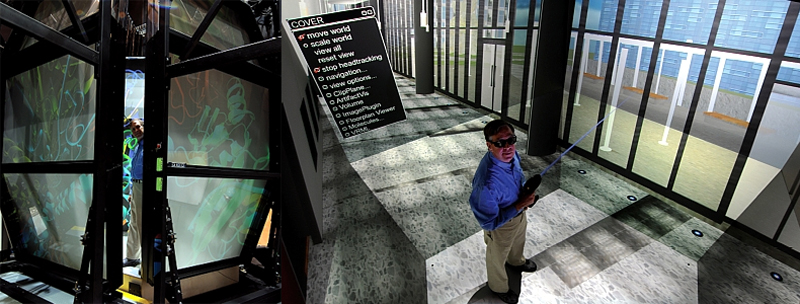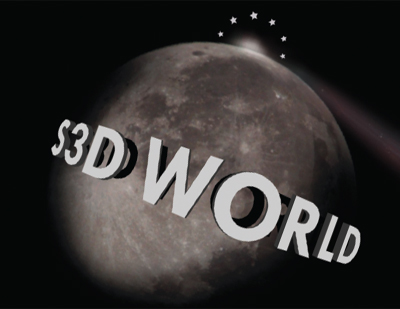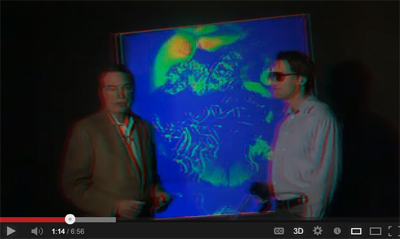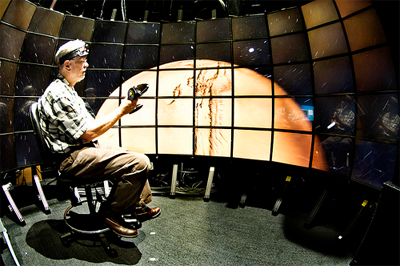
UC San Diego to Host Workshop on Future of Stereoscopic 3D Cinema
International Experts to Discuss Emerging 3D Technologies at Feb. 5-7 Event
By:
- Emily Bass
- Doug Ramsey
Published Date
By:
- Emily Bass
- Doug Ramsey
Share This:
Article Content

Calit2 senior research scientist Tom DeFanti in StarCAVE VR environment, using polarized glasses to navigate model of Atkinson Hall in S3D (but in 2D for this image).
What exactly is stereoscopic three-dimensional (S3D) cinematography? How does it differ from other 3D filmmaking techniques? Is S3D here to stay for future theatrical experiences—or will it fall by the wayside like such forgotten technologies as Nintendo’s 1995 Virtual Boy gaming console or the Sensorama – the earliest virtual-reality “Experience Theater” patented in the 1960s?
University researchers, audiovisual experts and creative professionals from across the globe will gather Feb. 5–7, 2013, at the University of California, San Diego to tackle pressing questions about the rapidly-evolving role of S3D in cinema and the visual arts.
The number of feature films in stereoscopic 3D released in U.S. theaters since "Avatar" opened in 2009 has gone up 7-fold to 43 films in 2012. Meanwhile, director James Cameron is reportedly planning to film the "Avatar" sequels in a new High Frame Rate (HFR) format at 60 frames per second (vs. 24 frames per second for today's standard films). Photo courtesy 20th Century Fox
The Stereoscopic 3D Cinema Workshop will be held in the high-tech theater complex in Richard C. Atkinson Hall on the UC San Diego campus. Hosted by the UCSD division of the California Institute for Telecommunications and Information Technology (Calit2), the three-day event is co-produced with the Prague-based International Centre for Art and New Technologies (CIANT) as part of its international S3D World training initiative funded by the European Union. The workshop will focus on emerging trends in S3D, as well as integrating this technology into the ‘mixed reality’ of real and virtual imagery.
“S3D World brings together American, European, and Japanese audiovisual experts for the purpose of advancing our understanding of how S3D fits into the film production cycle, from pre-planning to post-production,” said Pavel Smetana, CIANT’s programming director. “This event presents an excellent opportunity for scientists and production personnel working in some of the most technologically advanced areas of the world to collaborate on defining the future of stereoscopic 3D, both in filmmaking and across the mass-media spectrum.”

Logo of the Stereoscopic 3D Cinema training initiative funded by the European Union.
The Stereoscopic 3D Cinema event is the second of three workshops organized by S3D World, and is the only one to be presented in North America. The creative, multidisciplinary nature of Calit2 and the university’s Arthur C. Clarke Center for Human Imagination, which are both sponsors of the February workshop, made UC San Diego the ideal venue for this event, said Todd Margolis, Assistant Project Scientist at Calit2, who is coordinating the S3D World program in San Diego. “Calit2 and the Clarke Center bring together critical thinking and emerging technology to help advance the art and science of 3D cinema,” noted Margolis. “With this workshop, UC San Diego is opening doors to a creative, tech-savvy future that will encompass novel ways of participating in an increasingly complex set of immersive experiences.”
Additional event sponsors include KMD, the Graduate School of Media Design at Keio University in Japan; the European Commission’s MEDIA Mundus Media Programme; and Sony.
Stereoscopic 3D

Calit2 produced its first S3D short video for the YouTube 3D channel, featuring Calit2 director Larry Smarr (at left) and research scientist Jurgen Schulze talking about quantified health. To watch the video (3D glasses required), click here.
Until recently, the term “3D” usually referred to three-dimensional images that appear to have depth, but are displayed on a 2D platform – from 3D drawings on a piece of paper, to a computer display or projector showing a Powerpoint pie chart. Although computer gaming has radically advanced the power of 3D computer graphics, most consumers still experience these games on 2D displays.
“Stereoscopic 3D is the act of viewing something in true 3D – just like the way we see the physical world around us,” explained Calit2’s Margolis.
Advances in S3D technologies and the conversion of many cinemas to digital projection have fueled a proliferation of movie theaters capable of showing S3D movies under a variety of different formats (e.g., RealD, Dolby 3D and MasterImage 3D) and brands (Disney Digital 3D, for example). In turn, Hollywood and independent production companies have ratcheted up the number of films hitting U.S. movie theaters – from five in 2009 when Avatar was released, to 43 in 2012, a more than 7-fold increase. In some, the S3D effects are created during filming; in others, it can be done in post-production (which accounts for the large number of animated movies produced in 2D and now being converted and re-mastered for release in S3D).
In general, audiences of S3D movies are viewing footage that has been transformed using computers to make use of the “stereo” effect of how our eyes and brain work together to perceive moving images. In S3D, two images are superimposed, and viewers typically must wear special glasses that permit each eye to perceive one of the two images; the viewer’s brain then “stitches” the two images together into a single image with a realistic depth of field.
Calit2 and S3D

Calit’s Dan Sandin in front of Varrier autostereoscopic 3D wall display – offering S3D without glasses
The UCSD Division of Calit2 is a natural venue for the S3D Workshop. In addition to having incubated CineGrid, a major effort to prototype high-bandwidth solutions for digital cinema, Calit2 engineers have developed new ways to improve on S3D, including techniques for viewing S3D with no glasses required. To achieve this so-called “autostereoscopic 3D,” Calit2 and University of Illinois at Chicago researcher Dan Sandin was one of the first to use a photographic film barrier screen affixed to a glass panel mounted to the front of an LCD display. Similar technology used in some smart phone displays and handheld game consoles creates the glasses-free S3D imagery by using small lenses to direct each of the stereo pairs of images to the correct eyes, effectively halving the screen resolution to accommodate both the left and right images within the same display. In 2006, Sandin led the team that developed and deployed the first large-scale Varrier autostereoscopic 3D display system, a cylindrical wall of 35 LCD displays providing 80 million pixels (40 megapixels per eye), built in the Immersive Visualization Lab at Calit2’s Atkinson Hall headquarters.
“We referred to Varrier as a freer virtual reality system,” recalled Margolis, a co-developer of the Varrier system. “The display eliminates the need to wear special glasses to see the stereoscopic image as well as uses special camera tracking so that users could just walk up to the system and be instantly immersed in a virtual world without putting on any special glasses or tracking hats or gloves.”
Sandin and Calit2 senior research scientist Thomas A. DeFanti also built the first CAVE virtual-reality environment at UIC’s Electronic Visualization Lab in the mid-1990s, and the higher-resolution, higher-contrast StarCAVE at Calit2 in 2005. Polarized glasses are required, but the five-sided StarCAVE offers 360-degree, stereoscopic 3D (primarily for scientific visualizations) – offering an immersive “virtual reality” experience to the viewer.
While fully-immersive or autostereo cinema is not going to happen anytime soon, the explosion of interest in S3D movies has sparked innovation throughout the workflow, from pre- to post-production and display technologies. Most recently, “The Hobbit: An Unexpected Journey” became the first major release shot in High Frame Rate S3D at 48 frames per second (which in principle should make visuals look more realistic than if they were shot at the standard 24 frames per second). But when it arrived in theaters in December 2012, “The Hobbit” displayed at select U.S. theaters at the higher frame rate received mixed reviews. Other studios have been slow to commit to the format, but James Cameron is believed to be planning to shoot his “Avatar” sequels at an even higher 60 frames per second.
Workshop Schedule
Briefly, the three-day Stereoscopic 3D Cinema Workshop schedule is as follows:
- Feb. 5 — Prague-based filmmaker Tomas Petran will introduce S3D principles, techniques, and state-of-the-art filmmaking equipment to attendees, followed by a hands-on training excursion to La Jolla Cove for an underwater S3D shoot.
- Feb. 6 — European filmmakers and UC San Diego scientists and visual artists will discuss such thought-provoking topics as improving S3D technology for enhanced viewer experiences and exploring future applications of gaming, “mixed reality,” and datamoshing in S3D cinema. (Datamoshing is the practice of using intentionally corrupted digital video as a form of art.) This day will close with an interactive tour of Calit2’s advanced visualization systems.
- Feb. 7 — Attendees will compile, assess, and edit footage from the La Jolla Cove shoot and other workshop events, and will then view a short film crafted from these recordings.
Each day’s events start at 10 AM in the Calit2 Theater, located on the first floor of Atkinson Hall on the UC San Diego campus. The complete Stereoscopic 3D Cinema Workshop schedule is available online at http://s3dworld.ciant.cz/ucsd-workshop.
Share This:
You May Also Like
Stay in the Know
Keep up with all the latest from UC San Diego. Subscribe to the newsletter today.


